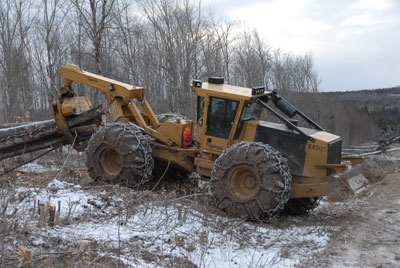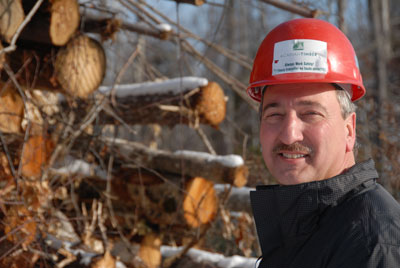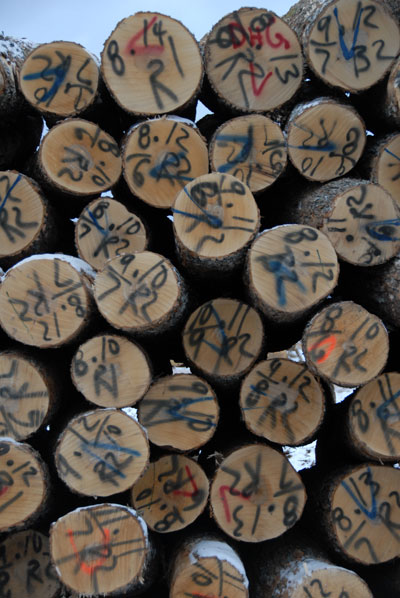
Features
Forestry Management
Harvesting
Eastern GIANT
Anywhere you travel in New Brunswick and Maine, you are likely to come across Acadian Timber. The company is one of the largest timberland operators in the region and owns almost 450,000 hectares (1.1 million acres) of private land, 92% of which is productive forestland.
November 10, 2011 By Bill Tice
 Anywhere you travel in New Brunswick and Maine
Anywhere you travel in New Brunswick and Maine“We own 310,000 hectares (765,000 acres) here in New Brunswick and another 126,000 hectares (311,000 acres) across the border in Maine,” explains Norm Haché from his office in Plaster Rock, N.B. Haché is a registered professional forester and a superintendent for the company. “We also manage 532,000 hectares (1.3 million acres) of crown land here in New Brunswick,” he adds.

But it’s not just land management and logging that keeps Acadian Timber busy. The company, which employs approximately 135 people and keeps 450 plus contractor employees working, owns and operates its own seedling nursery, manages its own silviculture programs and builds its own roads. They also open up their private timberlands to the public through an extensive recreation program that allows access for camping, hiking, hunting, fishing, snowmobiling and ATV use, and they have a lease program in place for recreational and lakeside property.
Wide Customer Base
On the logging side, Acadian harvests softwood and hardwood for well over 100 customers, primarily in New Brunswick, Quebec and Maine. That includes pulp and paper producers such as the AV Group, Fraser Papers, and Domtar, panel producers, including Louisiana Pacific and JM Huber Corporation, and major sawmill and value added wood products companies such as JD Irving, Félix Huard Inc., Bégin and Bégin Inc., Chaleur Sawmills, Groupe Savoie and Fraser Papers’ solid wood group. Between Acadian’s own timberlands in New Brunswick and Maine, they have a “long run sustainable yield” of 928,000 cubic metres per year – 651,000 cubic metres on the Canadian side of the border and 277,000 on the U.S. side. They also have an annual allowable cut on the New Brunswick crown land of 1,100,000 cubic metres, of which 650,000 cubic metres is harvested by sub-licensees, while the balance is handled directly by Acadian Timber.

In addition to supplying roundwood for wood products and pulp and paper production, Acadian plays a major role in the supply of biomass materials for power generation. It’s a business they are no stranger to as they were the forest management group for Fraser Papers until January 2006, before becoming part of Brookfield Asset Management Inc., which is a global asset manager focused on property, renewable power and infrastructure assets. Brookfield, which has over $100 billion of assets under its management, now controls over 50% of Acadian Timber Corp and also holds a controlling interest in Longview Timber, Fraser Papers and B.C.’s Island Timberlands. While Acadian was part of Fraser Papers, they produced biomass materials for a co-generation power plant that was installed at the company’s pulp and paper mill in Edmundston, N.B., in the mid-1990s, and as early as 1989 they were shipping biomass to a company in Maine. Over the past five years Acadian’s Haché says they have averaged about 350,000 tonnes of biomass annually, making the company one of the largest biomass suppliers in New Brunswick. Part of the biomass volume is sourced through a major slash recovery program where tops and branches from more traditional roundwood logging sites are converted into biomass. For more on Acadian’s biomass activities and its slash recovery program watch for the May/June issue of our sister publication – Canadian Biomass.
Contractor Operations
While riding in his pick-up truck on the way to a logging block for a discussion with one of his key contractors, Haché explains that they have nine contractors for harvesting saw, pulp and specialty logs and four for biomass, but two of the contractors cross over and have crews that handle both. That includes his largest contractor, Boyd B. Harding from Plaster Rock, who we are on our way to see.
“We handle logging, chipping and trucking,” says Darren Burgoyne, trucking supervisor and a senior manager at Boyd B. Harding as a loaded chip truck leaves the block we just arrived at. “That’s one of the 18 Western Star trucks we own,” he notes, adding that in addition to the logging business, the company has diversified and also now owns Tobique Western Star, which is the truck manufacturer’s dealer in northwest New Brunswick.
Burgoyne says the logging company, which was started by Boyd Harding as a solo effort around 35 years ago, has grown substantially, and today it has upwards of 80 employees year round. Harding still heads the company, which now runs seven crews on a regular basis – three for handling logs that will go to sawmills, panel mills and pulp mills, and four for biomass harvesting and processing. Burgoyne, who grew up in Plaster Rock and has been with the company for 23 years, says Acadian Timber is by far their largest customer, adding that they typically harvest about 200,000 cubic metres of roundwood annually for Acadian and last year processed close to 240,000 tonnes of biomass for the company.
The equipment stable at Boyd B. Harding has also grown substantially over the years, and today they run a fleet of top name gear, including a Tigercat 822 and two Tigercat 860 feller bunchers, four Caterpillar 322 machines all equipped with Denharco delimbing heads, and 16 skidders – one is a Tigercat E620C, while the balance of the skidders are Cat 524, 535 and 545 models. “We have two skidders working with every delimber and each site has at least one spare skidder in case of breakdowns,” Burgoyne explains. “That way we can keep our productivity up.”
Log loading is all contracted out, while on the biomass side, the company’s four Morbark 30-inch whole tree chippers output straight into waiting chip vans. Each of the Morbark chippers has its own dedicated Caterpillar skidder for moving materials to within reach of the chipper’s grapple.
The company also handles some road building and Burgoyne says they generally build 50 to 75 kilometres of mostly spur roads every year. Typically, they run two roada building crews. One is equipped with a Cat 325 excavator and a Cat D6T dozer, while the other crew has a Cat 320 and D6N combo. The company also has a Cat D6R dozer for brush work on the road sites.
Moving all of the Harding equipment between blocks is taken care of by a pair of float-equipped trucks that are also used to move equipment for other Acadian contractors. Harding is also contracted to keep Acadian’s roads clear in winter, a task that is handled by two snow ploughs equipped with blades that can grind ice. One snow plough is a Ford, while the second is an International.
High Tech
On the trucking front, Boyd B. Harding has embraced technology, from purchasing a fleet of lightweight yet tough trailers from Quebec-based Manic Trailers that are equipped with air ride technology and gauges for ensuring weight restrictions are met, to equipping each truck with a global positioning system (GPS) that records speed, downtime and travel routes. “We call it ‘the black box’ and it provides me with a printout every Monday that shows exactly what each truck did for the previous week,” says Burgoyne, who spent the first five years of his career with the company as a truck driver. “If I see on the printout that a truck sat in the woods for an hour and a half, I can start asking why, and even in terms of speed, the trail the truck covered will turn a different colour if they exceeded the speed limit. The units are manufactured by Shadow Tracker and our cost was about $700 per truck. It was another $1500 for the base unit, but in my opinion the payback was very quick.”
High tech goes beyond the trucks at Boyd B. Harding as the company’s feller bunchers are also equipped with GPS, which is a requirement for contract loggers working for Acadian Timber. “We equip the bunchers with Garmin 3010 GPS units,” explains Haché. “These are more durable than your average consumer model and they allow us to load up the block boundaries for the operator. The operators can also see where the roads and creeks are and they even have access to aerial photos of the block. Having this type of technology certainly reduces errors in harvesting.”
Some of the other logging equipment operating for Acadian has MultiDat technology develop by FPInnovations, which provides utilization rates for the machines. “This is really useful for establishing rates, checking volumes and identifying problems that are reducing machine utilization,” explains Haché. “If a machine isn’t performing as it should, we can look into the situation and see if it is a maintenance problem with the machine or something the operator isn’t doing quite right that can be corrected with some training.”
The Sort Yard
You get some idea of how much volume Acadian Timber harvests and processes when on the Boyd B. Harding block, but it isn’t until Haché drives through Acadian Timber’s sort yard near Plaster Rock that you really get a sense for the volume and diversity of products they produce. As he points out the various sorts that stretch off into the distance you start to understand how complex the business is. Stepping out of the pick-up in an area reserved for veneer peelers, you can see the sorts go even deeper. Just in this small section, they have six sub-sorts, with everything from bird’s eye maple for high end car dashboards to plywood grade veneers, all segmented out for just-in-time delivery to customers.
“It is a complex business but that’s the way we like it,” says Haché. “It provides us with the diversity we need to survive through the tough times like what we are currently facing, and it helps the company remain profitable, which is good for all of us that work here, our contractors, and the community in general.”
Print this page